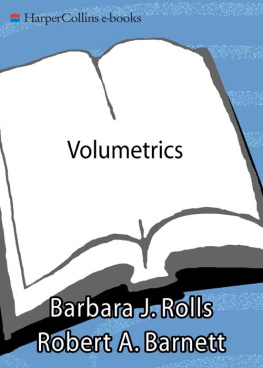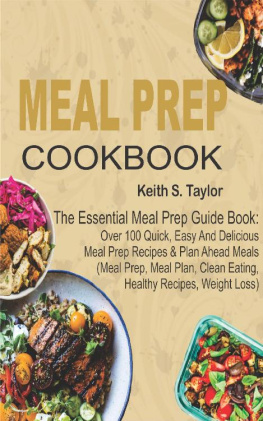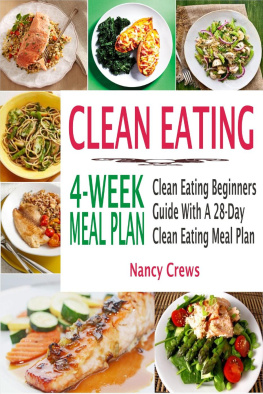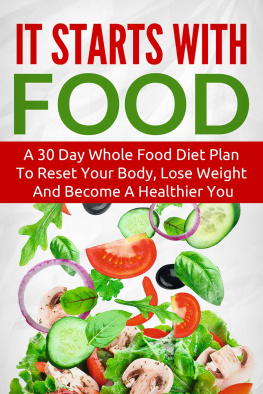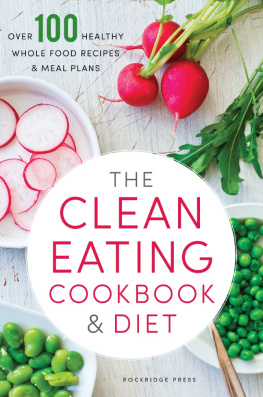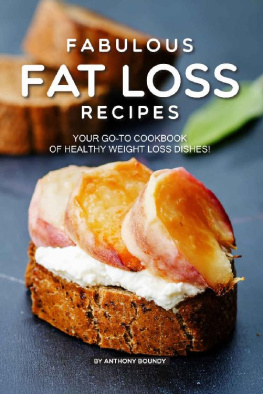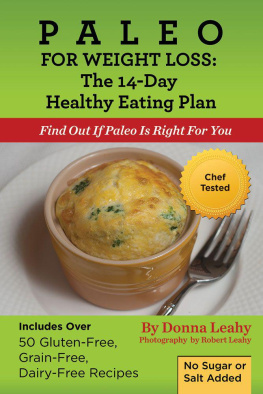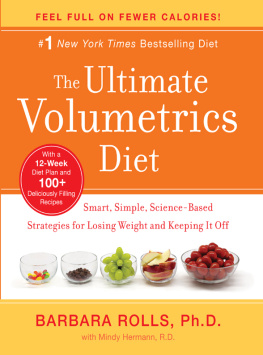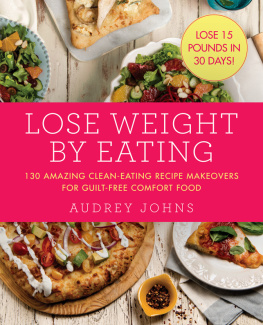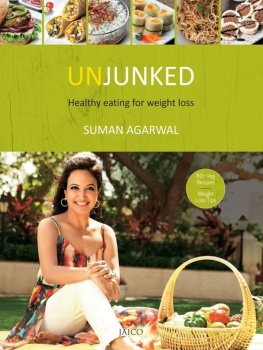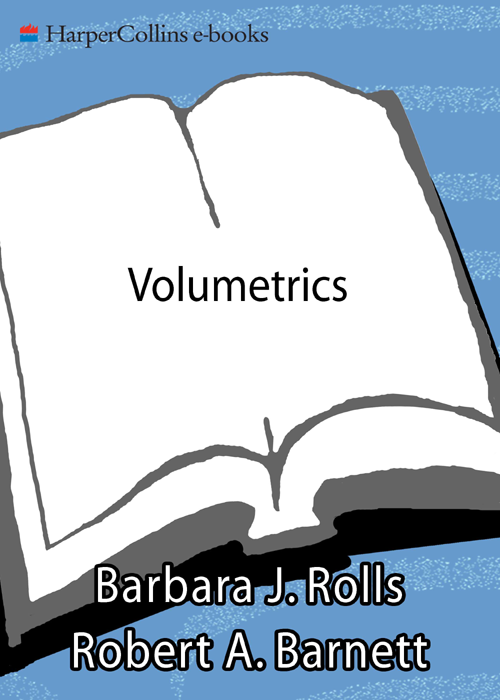The Ultimate Volumetrics Diet
Volumetrics
The Volumetrics Weight-Control Plan
The Volumetrics Eating Plan
Volumetrics
Feel Full on Fewer Calories

Barbara Rolls, Ph.D., Robert A. Barnett

To the staff and students in the Eating Lab
and to the many participants in our studies
who have helped us to understand why people eat
Contents
WELCOME TO VOLUMETRICS, the first book to use breakthrough new research on the science of satiety to help you control your eating habits. What is satiety? Its the feeling of fullness at the end of a meal, the feeling that you are no longer hungry. The more satiety you feel after a meal, the less youll eat at the next one.
Satiety is the missing ingredient in weight management. Cut calories by simply eating less, and youll feel hungry and deprived. You may be able to stick to such a diet for the short term, but to become successful at lifelong weight management, youll need an eating pattern that lets you feel full with fewer calories.
The primary way to do this is to get smart about your food choices. For any given level of calories, some foods will have a small effect on satiety, others a large one. The right food choices will help you control hunger and eat fewer calories, so you can lose weight, keep it off, and stay healthy.
Theres no secret to weight management: Consume fewer calories and burn more in physical activity. You cant lose weight without controlling calories. But you can control calories without feeling hungry. Feeling full and satisfied while eating foods you like is a critical component of our approach to weight management.
The basic strategy of Volumetrics is to eat a satisfying volume of food while controlling calories and meeting nutrient requirements.
THE FOODS YOU CHOOSE
Which foods should you choose?
Surprisingly, foods with a high water content have a big impact on satiety. But you cant simply drink lots of water, which quenches thirst without sating hunger. Youll need to eat more foods that are naturally rich in water, such as fruits, vegetables, low-fat milk, and cooked grains, as well as lean meats, poultry, fish, and beans. It also means eating more water-rich dishes: soups, stews, casseroles, pasta with vegetables, and fruit-based desserts. On the other hand, youll have to be very careful about foods that are very low in water: high-fat foods like potato chips, but also low-fat and fat-free foods that contain very little moisture, like pretzels, crackers, and fat-free cookies.
Why is water so helpful in controlling calories? It dilutes the calories in a given amount of food. When you add water-rich blueberries to your breakfast cereal, or water-rich eggplant to your lasagna, you add food volume but few calories. You can eat more for the same calories. This property of foodsthe calories in a given portionis the core concept of this book. We call it by its scientific term, energy density.
Water is only one of many food elements that affect satiety and energy density. In addition to water, fiber can be added to foods to lower the calories in a portion. It provides bulk without a lot of calories. So by strategically increasing the water and fiber content of mealswith the addition of fruits, vegetables, and whole grains you can dramatically cut the calories per portionyou lower the energy density. On the other hand, the component of foods that increases the energy density the most is fat. Fat has more than twice as many calories per portion as either carbohydrate or protein. So if you cut fat, you can lower the energy density of a meal. You can combine these strategies: Increase the water and fiber content of foods while lowering the fat content to get satisfying portions with few calories.
This book is based on recent research showing how foods affect hunger and satiety, which in turn has led to new ways to manage weight. Each of the major elements that makes up food fat, carbohydrates, protein, waterhas an effect on satiety. So do other dietary components: sugar, fiber, alcohol, and sugar and fat substitutes. In the next part of the book, we explore these influences in detail so you can learn the basic principles of choosing a lower-calorie, more satisfying diet.
SATISFYING PORTIONS
If youve suffered through dietary deprivation to lose weight, you may find it hard to believe that you can eat more food, feel full, and still reduce your total caloric intake. To make our program work, some people, if they choose lots of foods that have only few calories in a portion, may actually have to retrain themselves to eat larger portions than they do now.
We wont ask you to greatly restrict your food choices. You wont have to cut out all the fat from your diet, live on rabbit food, subsist on foods on a free list, or avoid any food. Volumetrics allows a wide choice of foods. Youll be able to eat bread, pasta, rice, beef, chicken, fish and seafood, dairy products, vegetables, and fruits.
To do so while cutting calories, well show you how to make changes such as adding vegetables to a risotto, or choosing fruit over fat-free cookies for dessert. Youll also gain greater understanding of the kinds of foods that are deceptively easy to overeat, whether its cheese, chocolate, raisins, or pretzels. We wont ask you to ban them. Thats not our style, because its not a style that works. Instead, we will give you specific strategies so you can enjoy them without taking in too many calories. Volumetrics is not really a diet at all, but a new way to choose satisfying, lower-calorie foods.
While we emphasize lowering the energy density of your dietary pattern because thats the best way to eat a satisfying amount of food, we dont want you to get the impression that energy-dense foods are bad or forbidden. Who wants to go through life without chocolate? Favorite foods, even if they are high in energy density, have a place in your dietary pattern. But you will have to plan for them. If you rely on the bodys satiety signals to stop you eating chocolate, youll consume too many calories. So youll need to satisfy your hunger with foods of lower energy density, and then enjoy high-energy-dense foods in appropriate portions. If the meal itself is satiating, a half-ounce of chocolate is a satisfying ending.
Our nondieting approach extends to the weight loss program, which emphasizes only a modest caloric deficit, rather than a large one that results in quick weight loss. You may lose weight more gradually than on other weight loss programs, but you wont feel deprived.
Because we emphasize foods with plenty of volume for their calories, we call our book Volumetrics. Were interested in both the volume and the weight of food you can eat since both affect satiety. If you follow our suggestions, your plate will be full of food and you will feel full. By making it easier to cut calories, this approach makes it easier to reduce the volume thats most troublesome: your own.
HATS INCLUDED INVOLUMETRICS
Volumetrics
Next page
